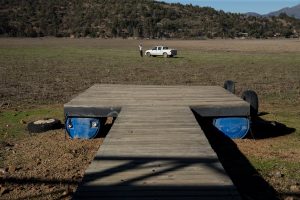
Valdivia de Paine, Chile, Jul 16 (EFE).- The deep cracks in the dry basin of Aculeo Lagoon, south of the Chilean capital, are wounds in the earth caused by diminishing rainfall since 2010 in the central part of the country as a direct result of climate change.
Parched sand clods now cover the surface of what 10 years ago was an oasis enjoyed by citizens of Santiago as a recreational area.
Aculeo Lagoon dried up for good in May 2018, and where once there were many rowboats, canoes and nautical sports, today horses and cattle graze amid the dry reeds dying from the lack of water.
After six months of work analyzing the case, experts from the University of Chile confirmed that the disappearance of Aculeo Lagoon was because rainfall between the years 2010 and 2018 was approximately 38 percent less than the historical average.
“It’s a very worrying situation because according to all climate-change forecasts, what is happening now with this precipitation pattern is not expected to reverse itself. It is expected to continue in the years ahead,” the professor of Forestry Sciences at the University of Chile, Pilar Barria, told EFE.
Aculeo Lagoon, which previously covered 1,210 hectares (3,000 acres) with water renewed by seasonal rains flowing down from the mountains surrounding it, is now a desert with deep cracks in the earth and whose nautical past may never return.
“All climate predictions are uncertain. Perhaps in one or two years the rains could return, but if we base our estimates on the models of climate change, we see they indicate that this will be the new normal. The forecasts say that Chile will have even less rain toward the middle and end of the century,” the academic said.
From the center of the lagoon bottom, looking toward what was the beach several years ago, are seen hanging some 4 meters (13 feet) above-ground the useless, shabby boats that went from sailing or being rowed across the water to being trapped and rotting away above the dry sand.
Aculeo Lagoon is not the only such case in Chile or the world, but it could be a perfect example of the final consequences of climate change.

“It’s part of a global phenomenon that can be seen in other forms at similar latitudes, not just in Chile but also in southeastern and southwestern Australia, and in the Northern Hemisphere as well,” Barria said.
The drought in the lagoon provides a perfect explanation of the situation in central Chile, which continues to become more arid due to the effects of global warming and the failure to improve criteria for the use of water resources.
Central Chile is a natural barrier between the arid deserts of northern Chile and the south, rainy and wooded, and its slim configuration between the Pacific Ocean and the Andes – some 150 kilometers (93 miles) – should form a basin sufficiently supplied with water.
However, most of that comes from the rains, and these “have diminished,” professor Barria said.
“For nine straight years there has been less rainfall, a reduction of approximately 38 percent compared to the historical average, and that signifies a considerable hydric deficit,” she said.
Shrinking water resources mean less water in the aquifers, so there is much less available.
